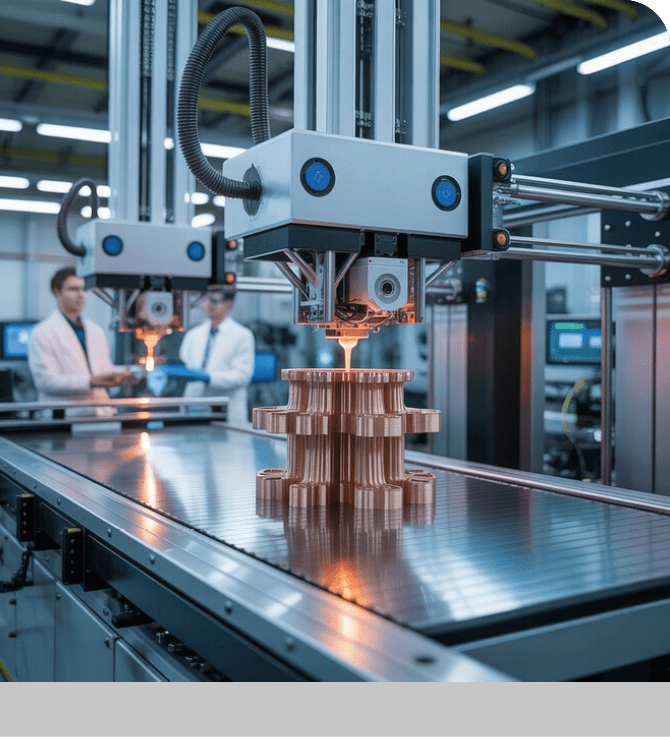Research and development
Nornickel’s contribution to the Technological Leadership national goal
Targets and objectives: | Nornickel’s performance highlights and plans |
| a) Ensure technological independence and foster new markets in selected areas [...] |
|
| c) Secure a position for the Russian Federation among the world’s top 10 countries by R&D volume by 2030 d) Increase domestic R&D spending to at least 2% of GDP by 2030, including at least a two‑fold increase in private sector R&D investments |
|
| e) Achieve a 1.5‑fold increase by 2030 in the share of domestically produced high‑tech goods and services based on proprietary R&D in total national consumption of such goods and services in the Russian Federation, compared to 2023 levels |
|

Nornickel’s contribution to the Efficient and Competitive Economy national project
Related federal projects
Nornickel’s key initiatives and focus areas
Nornickel’s long‑term growth and delivery on its strategic priorities rely directly on its scientific and technological efforts, which aim to improve production processes, provide technological support for operations, expand the product portfolio, and ensure the Company’s technological sovereignty.
The goals, objectives, principles, allocation of responsibilities, and decision‑making mechanisms in the area of science and technology are set out in MMC Norilsk Nickel’s internal R&D Management Policy. The Company’s R&D Panel is responsible for organising and conducting relevant consultations and expert reviews.
The increase in R&D and feasibility study spending in 2023–2024 compared to 2022 levels was driven by new project launches and improvements to operations and individual business processes
Feasibility study of permanent exploratory conditions for sulphide copper‑nickel ores of the Oktyabrskoye and Talnakhskoye deposits
Verification of shaft sinking rates for a project under existing constraints and recommendations for optimising mine development
Feasibility study on mining balance reserves within designated safety pillars and off‑balance reserves at the Kalargonskoye deposit
Main drainage complex of Skalisty Mine
Feasibility study on mining remaining reserves of sulphide copper‑nickel ores at the Kotselvaara and Semiletka deposits
Feasibility study on developing the mineral resource base at the Zapolyarny site
Development of general functional requirements for MMC Norilsk Nickel’s autonomous and remotely operated mine machinery
Selection of a technical solution for ventilating mine development workings within the Zapolyarny Mine project. Combined development of remaining disseminated ore reserves at the Norilsk‑1 deposit
Research on ionometric mapping and optimisation of pulp ionic content during flotation of copper‑nickel ores at the Company’s concentrators
Development of an updated nickel production operating procedure incorporating all technology solutions outlined in the updated Nickel Quality Improvement Programme
Most significant R&D and feasibility studies in 2024
Research and development of technical solutions to improve cobalt recovery from pyrometallurgical operations for finished products at Nadezhda Metallurgical Plant
Technical audit of Talnakh Concentrator’s tailings thickening section
Development of the operating procedure for processing ores and secondary resources of prospective composition for 2022–2024
Feasibility study on an implementation option of the NMP. CS‑2. Construction of ShP‑13.14
Development of Copper Plant smelting shop’s operating procedure
Revision of the operating procedure for a cobalt production facility with a capacity of 3 ktpa of electrolytic cobalt, incorporating all technological solutions outlined in the cobalt production restoration project
Determining the feasibility of increasing nickel and copper recovery into the bulk concentrate through the use of magnetic pulse processing within the existing process flow of Norilsk Concentrator
Providing research services to improve the thickening of flotation tailings at Norilsk Concentrator, including the development of process upgrades and enhancements
Technical and economic assessment of the viability of mining high‑grade, cuprous, and disseminated copper‑nickel ores of the Talnakhskoye deposit’s southern flank
Conducting pilot tests of a ceramic filter element for the gas cleaning system at Nadezhda Metallurgical Plant and developing technical specifications for the design of upgraded gas cleaning units
Key results of R&D and feasibility studies in the reporting year:
- research showed that ion‑selective electrodes can effectively control the consumption of specific reagents, resulting in improved concentrate quality and increased metal recovery into concentrates
- recommendations were developed following an inspection of the production process at Norilsk Concentrator, which focused on concentrator operating modes and identified potential areas for improvement
- the technological performance metrics for the copper tankhouse were adjusted, resulting in better product quality and reduced defect rates
- planned production volumes were achieved for Nornickel Plating Grade full plate nickel cathodes and Nornickel High Purity premium nickel cathodes
- shipments of PGM‑depleted converter matte exceeded the target, reaching over 16.6 kt vs the planned 12.5 kt
- a 19.8% reduction in SHP electrode consumption was confirmed
- the performance of core process equipment under increased raw material (converter matte) loading conditions was confirmed
- the ability to process 2.5–9.0 tonnes of pellets and agglomerates per cycle in the slag‑cleaning furnace at Nadezhda Metallurgical Plant without compromising the quality parameters of the smelting products (slag, matte) was demonstrated
- the ability to effectively process spent autocatalysts was confirmed
- for the chlorine, caustic soda, and hydrochloric acid production project, technical solutions were developed, including a preliminary CAPEX estimate
- an equipment configuration for electrochemical nickel sulphate production was put in place
Research and technology development are conducted by Nornickel Group enterprises both in‑house and through collaboration with specialised engineering companies and Russian universities.
Development of palladium‑based technologies
46

A unique set of properties:
- higher catalytic activity
- hydrogen permeability
- oxidation resistance
- electrical conductivity and magnetic susceptibility
A wide range of industrial applications as:
- catalysts (to accelerate chemical processes)
- components of creep‑resistant alloys (to prevent oxidation and ensure mechanical strength)
- contact coatings (to reduce electrical signal loss).
Nornickel’s dedicated research centre (the “Centre”) is focused on the development, testing, and commercialisation of new palladium‑based materials that support the accelerated transition to green technologies and help reduce carbon footprints. The Centre’s portfolio includes 25 developments across three key focus areas.
Focus areas and results of the Centre’s activities
Greentech
(focus area: alternative energy)
New palladium‑based materials increase the efficiency of the entire production chain:
- electrolyser catalysts increase energy efficiency by 5%–10%
- membranes for ultrapure hydrogen production reduce hydrogen production cost threefold
- fuel cell catalysts offer a 5
% –10% increase in activity and a twofold reduction in degradation
In 2024, all materials underwent industrial testing with Chinese consumers. The first commercial batches are expected to be delivered in 2025
Laboratory testing of new palladium‑containing components designed for silicon and perovskite solar panels (offering a projected efficiency increase of 1–2 p. p.) is scheduled for completion in early 2025
The development of catalysts designed to enhance the efficiency of sustainable aviation fuel (SAF) synthesis from plant‑based feedstocks is planned for 2025
Traditional applications
(focus area: improving energy efficiency and reducing the overall carbon footprint)
Industrial tests were successfully completed, and the first commercial batch of new palladium‑containing anodes for water disinfection via electrolysis was produced. These new anodes demonstrate a 10%–20% reduction in energy consumption compared to existing alternatives, have a longer service life, and are more affordable. There are plans to scale this technology to other energy‑intensive electrochemical processes for nickel, copper, and chlor‑alkali production
Industrial trials of glass fibre bushings with palladium‑based current leads designed to enhance energy efficiency and reduce product costs were successfully completed. There are plans to enhance the product by incorporating palladium into the alloy
High‑tech materials
(focus area: artificial intelligence and electrified transport)
Research and development efforts are currently underway to extend the service life of OLED displays by a factor of 2–3 through the integration of palladium‑containing components which increase the luminescence lifetime of blue LEDs
In parallel with these focus area‑specific initiatives, the Centre will also focus on completing fundamental research into the integration of new palladium catalysts into lithium‑sulphur batteries. The goal is to increase battery service life and power output while reducing weight, thereby enabling their use in the aviation industry.
The projects and initiatives pursued by the Company are aimed at achieving the goals outlined in Nornickel’s 2030 Socially Sustainable Development Strategy. These endeavours contribute to technological and societal progress through the application of Nornickel’s products.
Research and development of battery materials
In 2024, Nornickel inaugurated its Battery Technology Centre in Saint Petersburg, marking a new phase in the Company’s efforts to advance technological capabilities in the promising field of nickel‑containing cathode active materials – a key component in modern batteries.
The new centre will focus on the development and research of battery materials using state‑of‑the‑art process equipment unique in Russia, enabling the full cycle of synthesis and testing under specialised conditions.
Nornickel’s R&D centre has already produced the first samples of cathode materials for NCM 811+ chemistry, with further research planned to develop new products. The outcomes of the Battery Technology Centre’s efforts are expected to lay the groundwork for future projects in the battery materials sector.
.png)
Nornickel is investing significant resources in developing new R&D capabilities, which are set to become a vital element of the Company’s global strategy to expand its technological expertise. The establishment of a scientific foundation for the research and development of cathode active materials is one of the steps in implementing this strategy.
Vitaly Busko, Nornickel’s Vice President for Innovation
Additive manufacturing
Considering the scale of Nornickel’s operations, its focus on technological sovereignty and import substitution, as well as the remoteness of its host regions, additive manufacturing technologies have become an essential enabler of the Company’s operational continuity and future development. These technologies facilitate the scanning of broken parts, development of 3D printing documentation, and identification of material requirements for additive manufacturing. Computer modelling significantly reduces part replacement costs and enhances technical performance, resulting in components with longer service lives.
3D printers are deployed at multiple enterprises within the Group. On top of this, a dedicated 3D printing centre is currently up and running. Looking ahead, the Company is considering the construction of a dedicated large‑scale facility to accommodate 3D printers – not only to meet in‑house demand but also to serve the wider market.
